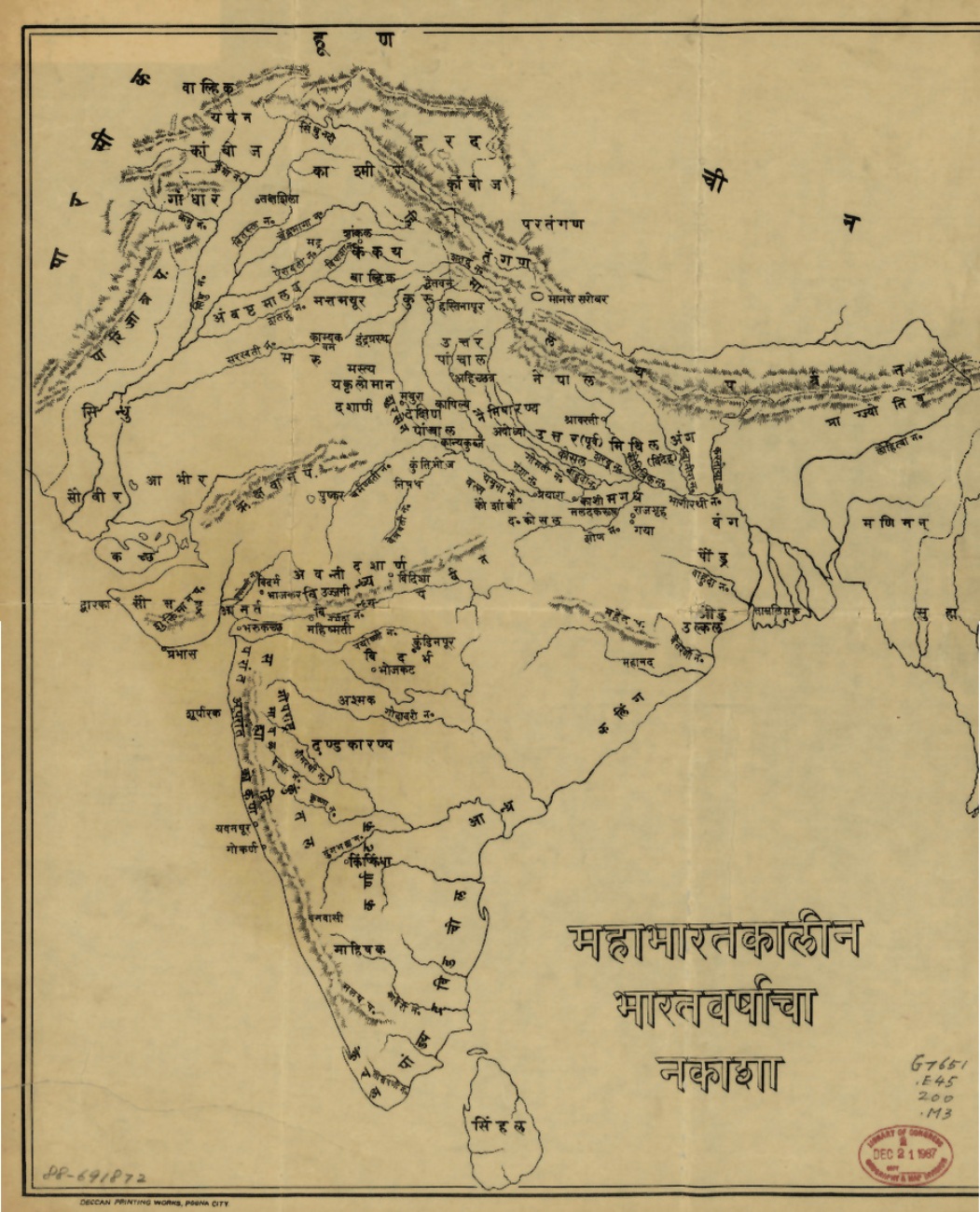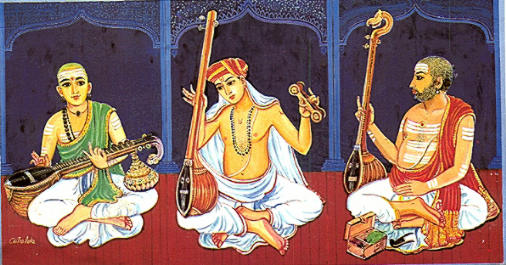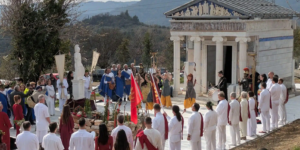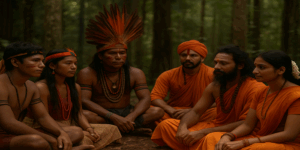One of the biggest ill-effects of the post-colonial ‘Idea of India’ is the confusion it created in the Indian mind about the country, its culture, its nation and state. While clarity exists in the minds of learned men who studied Indian/Hindu culture, many simply lack it. The idea of this write-up is not to analyze those confusions but to present a high level understanding of the different aspects that are now not seen clearly.
For instance many are concerned about the several divides that exist in India, in the name of region, religion, language, caste etc. While appreciating the ‘unity in diversity’, the lack of consensus as a retarding factor in the nation’s growth is seen as a result of such diversity or divides. But many do not have an idea of what the original notion of India, what its idea of unity, diversity and integration is. Unfortunately the modern idea of India is rooted in a complete ignorance of the real idea of India which is based on federalism, pluralism, tolerance. The attempt to create these artificially without seeing how they are actually present in the original Indian culture, creates both confusion and conflict between ideas which is otherwise unnecessary.
Traditional Idea of Bharata – The Rajya
The conceptual framework that underlies the culture and collective life in India is explained in http://centreright.in/2013/04/orient-and-occident-iii-structure-knowledge/. Traditional Idea of Bharata has two aspects, the rajya and rashtra. While rajya deals with the state (polity, administration etc) aspect, rashtra is the cultural-social-national aspect.
 Rajya is the traditional concept of state. The geo-political units of traditional Bharata varsha were kingdoms or rajya-s, which are now rendered obsolete and replaced with the current democratic state-union arrangement. However there is still a need to understand the original geo-political arrangement, which is more glued to the Indian culture and psyche. For ages, Bharata always had several janapada-s and rajya-s, and a political ‘union’ was almost never consisting of the entire Bharata varsha.
Rajya is the traditional concept of state. The geo-political units of traditional Bharata varsha were kingdoms or rajya-s, which are now rendered obsolete and replaced with the current democratic state-union arrangement. However there is still a need to understand the original geo-political arrangement, which is more glued to the Indian culture and psyche. For ages, Bharata always had several janapada-s and rajya-s, and a political ‘union’ was almost never consisting of the entire Bharata varsha.
At the same time different levels of consolidation always existed – janapada, rAyja, mahArAjya, samrajya, cakravarti etc were words used for kingdoms/empires of different spans. They were essentially hierarchical wherever applicable – for instance a cakravarti had rAjAs accepting his suzerainty, rAjA-s had smaller rAjA-s called sAmanta-s.
Historically there were always attempts to bring as many kingdoms as possible under an umbrella. The ashwamedha and rajasuya which are attested in ancient history, are examples. However it remains a fact that such attempts could succeed only partially, because the capability required for such an emperor who could bring the entire bharata varsha under a single umbrella is only rarely to be found. Those who successfully did so, are celebrated in Indian history – Sri Rama, Yudhisthira, Vikramaditya, Chandragupta Maurya etc.
The important thing to note is that these emperors emerged from different parts of the country, and made different places the capitals for their consolidation – Indraprastha, Pataliputra, Ujjain etc. While this seems to be stating the obvious, but there is more to the significance of a capital than being a place from where an emperor hails. To understand this, we need to see the backdrop of the Hindu notion of divine geography.
Divine Geography, the Backdrop
 India is a primarily spiritual civilization. Spirituality in India does not mean religious or meditation practices, though they are among the tools for spiritual practice. Seeing the world from a spiritual outlook is what spirituality is. In spiritual philosophy, causal, subtle and gross emanate in order from the supra-causal principle of existence.
India is a primarily spiritual civilization. Spirituality in India does not mean religious or meditation practices, though they are among the tools for spiritual practice. Seeing the world from a spiritual outlook is what spirituality is. In spiritual philosophy, causal, subtle and gross emanate in order from the supra-causal principle of existence.
Applying this awareness in the various facets of individual and social life is spirituality. At an individual level, mind-speech-action affect each other and with a rigorous practice of controlling one of these, the other two can also be controlled to achieve a complete alignment between these three (samyama).
This is yoga. In modern science energy is limited to physical/vital. However in Sanatana Dharma primal energy descends in different levels of subtlety into different levels of consciousness – the causal, subtle and gross. The subtlest form is unmanifest, then the intelligence principle, then the thought-current, then vibration/wave, then the physical. Thus thought (bhAvanAtmaka) is known to be a subtler form of energy than the vibration (spandanAtmaka), and in continuity with it. A spiritual view of energy is the reason why schools and practices like yoga was possible in India.
 An important area of study that that modern knowledge does not yet explore but had been part of Indian knowledge because of its spiritual outlook, is the study of divine geography or the study of energy-centers in a landscape. It is now well accepted not just in Hindu spiritual traditions but increasingly in the west, that there are energy centers in the human (subtle) body and that concentration of thought-currents and life-force in these centers and their control helps in achieving a healthier body and thought.
An important area of study that that modern knowledge does not yet explore but had been part of Indian knowledge because of its spiritual outlook, is the study of divine geography or the study of energy-centers in a landscape. It is now well accepted not just in Hindu spiritual traditions but increasingly in the west, that there are energy centers in the human (subtle) body and that concentration of thought-currents and life-force in these centers and their control helps in achieving a healthier body and thought.
Similarly the seers visualize energy centers in the landscape of Bharata. They decree that making these places capitals/centers for various pursuits is going to result in a long lasting and successful pursuit of the respective collective interests.
The spiritual regions are classified into punya, tapo, jnAna and karma bhUmi-s. Based on the same principle, several places are recognized as suitable centers for political, commercial, educational pursuits. With those centers as capitals Bharata achieved the heights of civilization and remained at a high point for several centuries. Takshasila, Kashmira, Kasi for instance have served consistently as educational centers, regardless of political ups and downs the country went through. Delhi served as a ‘cakrasthAna’ or the place of emperor and remained so in the Hindu psyche ever since Yudhisthira’s times, regardless of how many consolidations subsequently happened with different capitals. Even in their highpoints, the capitals of Vijayanagara and Maratha empires could not dislodge Hastina-Indraprastha as the cakrasthAna from the collective psyche.
Traditional Idea of Bharata – The Rashtra
 This idea of bharata varsha is essentially a concept of nation-culture, which comprises of 56 geo-cultural units traditionally called the chappan(na) desa-s (though some of these fall outside Indian borders). Understanding these desa-s is essential to understand the diversity and stratification in Indian culture. While the layout of rajya-s kept changing with political vicissitudes, while the rajya-s kept merging and breaking up into different empires, the desa-s remained to be regarded as the units that comprise the nation/subcontinent (varsha/khanda).
This idea of bharata varsha is essentially a concept of nation-culture, which comprises of 56 geo-cultural units traditionally called the chappan(na) desa-s (though some of these fall outside Indian borders). Understanding these desa-s is essential to understand the diversity and stratification in Indian culture. While the layout of rajya-s kept changing with political vicissitudes, while the rajya-s kept merging and breaking up into different empires, the desa-s remained to be regarded as the units that comprise the nation/subcontinent (varsha/khanda).
The practice of describing the span of empires in terms of desa-s, goes to show the significance of desa-s in the basic understanding of the subcontinent. Able emperors could control more than a desa, and a desa could also have multiple small kingdoms at times. But the desa as a basic understanding unit transcended the more transient and constantly realigning rAjya-s.
This is the reason why the stream of civilizational and cultural enrichment continued uninterrupted in the subcontinent irrespective of political realignments. This does not mean these aspects were completely unaffected by the patronage of rulers. Presence of a strong empire, resulted in patronage and high points of civilizational pursuits. However there was rarely any destructive effect on cultural diversity or identities of these desa-s.
Importantly, the desa remained a well-defined concept which is almost agnostic of the rAjya. For all non-political purposes, Bharata geography has often been described in terms of desa-s. For instance Varahamihira in his Brhat Samhita categorizes the desha-s of Bharata into different seismic zones. More on this can be seen in the paper “Earthquake prediction in Ancient India” by Prof. RN Iyengar (http://www.iisc.ernet.in/currsci/sept25/articles32.htm). Lawgivers dealt with validity of local customs and practices based on desa-s. Panini alludes to rules of grammar with respect to local language practices based on desa-s.
 The cohesion of peoples in the subcontinent and their cultural affinities in the diverse landscape, need to be understood on the basis of these desa-s. It also needs to be understood that these desa-s were regarded as part of Bharata. This tells us the nature of oneness of Bharata ingrained in the Indian mind for ages.
The cohesion of peoples in the subcontinent and their cultural affinities in the diverse landscape, need to be understood on the basis of these desa-s. It also needs to be understood that these desa-s were regarded as part of Bharata. This tells us the nature of oneness of Bharata ingrained in the Indian mind for ages.
The cultural affinities between peoples of the same desha are pronounced, and it is easy to find more similarity between cultural units/jAti-s (belonging to the same strata) of the same desa than people of same jAti of different desa-s. This is the reason we prefer the word geo-cultural unit for a desa.
Besides, an integral view of the entire bharata varsha as a rashtra is visible from several integration themes – for instance the Sakti peetha-s and Jyotirlinga-s, the spiritual unification centers that people cover. What more concept of geo-religious oneness does one require to see, than the sthala-purANa of Kanyakumari saying the Devi waits to get married to Siva coming from Kailasa of Himalayas? The landscape covered by Pandavas during their exile or Sri Rama during his exile are other classical integration themes.
Thus in the traditional Bharata, the different collectivities like jAti, desha, sampradaya acted as unification factors rather than as dividing factors between peoples. History of Bharata stands witness to the fact that such unity proved to be moer powerful than political oneness in keeping the society united. Wherever and whenever that cultural cohesion suffered either due to religious or political machinations, India suffered.
India the Nation-State
Given the original Hindu understanding of Bharata, it is easy to notice that the organization of India since independence is not exactly in line with the former. To be fair, the post-colonial Indian organization was an uphill task of integrating hundreds of princely states (which themselves have nothing to do with the desa-s). And they were subsequently organized into 25+ states supposedly on the basis of language.
While the choice of Hindi instead of Sanskrit as a national language (quite a close contender even by post-independence poll) had its issues, the main problem in linguistic division is that it revolts against the very concept of cultural diversity represented by linguistic diversity. For instance the Hindu rAjya-s preserved cultural and linguistic diversity while the states of today impose a single official state language. This is an anti-thesis of the cultural unity-diversity that prevailed in the nation for centuries.
 For example the Carnatic music supposedly of a ‘Kannada’ origin was enriched with thousands of ‘Telugu’ compositions, which are mastered by several ‘Tamilian’ artists. A geo-linguistic boundary is rather unimaginative arrangement compared to this, and this explains why we saw no scope for civilizational and cultural enrichment in post-colonial India.
For example the Carnatic music supposedly of a ‘Kannada’ origin was enriched with thousands of ‘Telugu’ compositions, which are mastered by several ‘Tamilian’ artists. A geo-linguistic boundary is rather unimaginative arrangement compared to this, and this explains why we saw no scope for civilizational and cultural enrichment in post-colonial India.
The derecognition of a nation that can exist agnostic of state conception, and more importantly a proxy-colonial state which is not founded in the long known Hindu ideals, resulted in a near-complete curtailment of Hindu culture, civilizational progress and self-governing and self-correcting ability.
Another major negative consequence is that in the current arrangement all those collective arrangements that earlier acted as integration motives, are now acting as disintegration motives. Religious, cultural and linguistic bonds are way stronger than regional urban-rural cultural bonds, and this explains why India today suffers more lack of unity at people level than in the pre-colonial times. Caste, language, region based rivalry and jingoism are essentially colonial and post-colonial phenomena.
Way Forward
 Several nationalistic initiatives sought to undo these caste-language-region disintegration motives in the last century. However to be able to reuse them as unifying and enriching factors is the real necessity, which requires a positive outlook towards these aspects – they cannot be seen as impediments in achieving unity. More importantly, these initiatives looked the wrong side – namely trying to correct or abolish the wronged institutions instead of addressing the causative factors that caused these wrongs.
Several nationalistic initiatives sought to undo these caste-language-region disintegration motives in the last century. However to be able to reuse them as unifying and enriching factors is the real necessity, which requires a positive outlook towards these aspects – they cannot be seen as impediments in achieving unity. More importantly, these initiatives looked the wrong side – namely trying to correct or abolish the wronged institutions instead of addressing the causative factors that caused these wrongs.
Whether it is the state interference through matters like affirmative action or linguistic boundaries. While there is a need to revitalize the traditional institutions, it should be remembered that their very nature is evolutionary and hence they have the inbuilt ability to self-correct and realign themselves to a new polity. This self-correcting nature of traditional Hindu institutions is not recognized or made use of by either socio-political reformers or governments. The real issue is with the way the state policies often disregarded the core traditions and civilizational health, and the way the policies often disadvantage the native culture and its traditions vis-a-vis the intolerant monotheistic traditions.
We think that there should be correctives in the fundamental approach that the state has taken to stem further decline of the social fabric and civilizational health, and to allow a revitalizing of Bharata. While there are several correctives already being suggested to take effect within the existing setup such as uniform civil code, we think there need to be more fundamental changes.
Align State with Nation
 The self-proclaimed secularist state of India has been conceding its alignment with nation step by step after independence. The original idea of India where the policy had an active participation from scholars with a profound knowledge of the social institutions, culture and human nature, is giving away under the name of secularism into a rather artificial leadership of rabble rousers with no basic understanding or vision of what policies really align with the long term interests and civilizational development of the nation.
The self-proclaimed secularist state of India has been conceding its alignment with nation step by step after independence. The original idea of India where the policy had an active participation from scholars with a profound knowledge of the social institutions, culture and human nature, is giving away under the name of secularism into a rather artificial leadership of rabble rousers with no basic understanding or vision of what policies really align with the long term interests and civilizational development of the nation.
If proxy-colonial education is half the reason for this, the other half is a self-defeating anti-Hindu, anti-pluralistic stand the leaders take in several policy matters. Policy’s purpose is national interest and not ideal romanticism, and this basic view is lost right from the days of Nehru.
Separating national interest from a religious ideal is necessary, and for this one needs to be able to define the scope of both. If religion is a matter of individual freedom and there are age-old traditions in the country for a common cause, the state needs to align with the latter as a national policy. Indian governments have systematically kept compromising on this, under the pretext of respecting ‘minority’ religious sentiments, which is essentially an anti-secular policy. In the face of state’s inability to align with nation’s core institutions, the state should at least remain agnostic of these and work with individual laws, and not make policies for specific groups.
Focus on Energy Centers
 As mentioned, from time to time different places have been identified as appropriate capitals for various activities of rejuvenation in the society. We need to take stock of our divine geography, liberate primary energy centers from their current use and restore their sanctity. The political and economic capitals of activities need to be realigned with the reviewed divine geography. This should be done with the guidance of seers who specialize this subject.
As mentioned, from time to time different places have been identified as appropriate capitals for various activities of rejuvenation in the society. We need to take stock of our divine geography, liberate primary energy centers from their current use and restore their sanctity. The political and economic capitals of activities need to be realigned with the reviewed divine geography. This should be done with the guidance of seers who specialize this subject.
For instance, in the new geography of Bharata (post partitions) the cakrasthAna may not ideally belong to the present Delhi. Besides, the nature of economic and political activity required for the day will determine the choice of capitals where power (economic, political, educational, scientific, industrial etc) needs to be concentrated.
Undo Monotheistic Impact
Monotheism is an implicit assumption in secularism, whose main articulation is a curtailment of church role in state matters. While the Indian constitution originally did not have this, it was eventually added in under communist pressure and subsequently things only worsened – the innumerable Indian groups which number much smaller than the followers of monotheism, are disadvantaged with the grant of special rights to predatory, exclusivist and intolerant monotheism’s under the pretext of minority rights. Therefore the restoration of pluralism and tolerance will need removal of both secular clause and special privileges for fake-minorities.
Cultural affinities and IOC
 While India is the primary shelter for Hindus, Hindu culture was until a few centuries ago spread in vast areas of south-east Asia. In the still remote past, it spanned Afghanistan and parts of central Asia not to speak of the global Hindu diaspora (see Bhiku Chamanlal’s book). India shares cultural bonds with several countries in the world, and the Hindu ideals like pluralism are now increasingly accepted in the world.
While India is the primary shelter for Hindus, Hindu culture was until a few centuries ago spread in vast areas of south-east Asia. In the still remote past, it spanned Afghanistan and parts of central Asia not to speak of the global Hindu diaspora (see Bhiku Chamanlal’s book). India shares cultural bonds with several countries in the world, and the Hindu ideals like pluralism are now increasingly accepted in the world.
Given this backdrop, India should strengthen bonds with tolerant oriental societies. Given that the current dispensation in China is hardly interested in pursuing an oriental worldview, India would be the center of such activity. This also explains why India is a primary target of predatory monotheism. The Indian Ocean Community is one such constructive idea, and India should invest in revitalizing its native institutions as well as in contributing to such communities which would be instrumental in erecting a world order which could successfully counter the occidental imperialist and monotheistic worldview.
by Skanda Veera.


































4 Comments